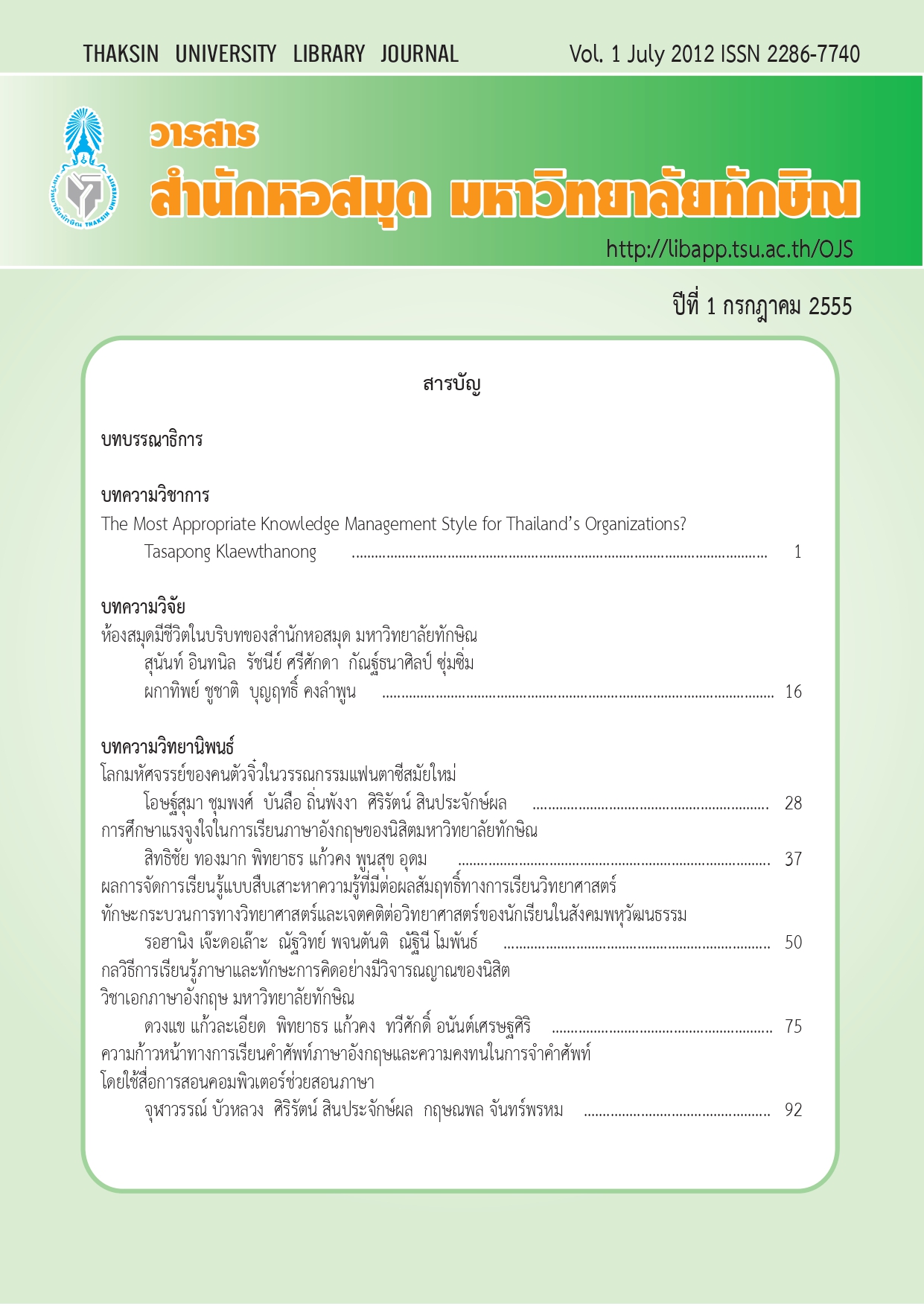A Study of Thaksin University Students’ Motivation in English Language Learning
Keywords:
Motivation, Motivational intensity and Motivational internal variablesAbstract
This research was studied the differences and relationships in motivation, motivational intensity, motivational internal variables and English proficiency between the high and low proficiency groups in 8 faculties subjects. The subjects were 1,530 first year TSU students in academic year 2010. The instrument was the questionnaire on subjects’ motivation, motivational intensity and motivational internal variables in English learning, the content validity was 0.95 and the reliability coefficient was 0.90. The data were statistically analyzed for frequency, percentage, mean, SD, t-test, F-test and Pearson correlation coefficient. The findings are summarized as follows : 1) There were differences and relationships between high and low proficiency groups in overall motivation, motivational intensity, overall motivational internal variables and English proficiency. 2) There were differences between faculties of study in their overall motivation, motivational intensity, motivational internal variables and attitudes in 8 faculties. There were related among motivation, motivational intensity and English proficiency in 6 faculties, but the motivational internal variables were related with their English proficiency only in 2 faculties.
References
ปฐมา อักษรจรุง และ บันลือ ถิ่นพังงา. (2545). รายงานวิจัยฉบับสมบูรณ์โครงการสภาวะการเรียนการสอนภาษาอังกฤษที่มิใช่วิชาเอกหรือโทในระดับบัณฑิตศึกษาในภาคใต้ของประเทศไทย. สงขลา : มหาวิทยาลัยสงขลานครินทร์.
Brown, H.D. (2000). Principles of language learning and teaching (4th ed.) White Plains, NY : Longman.
Chompoonut Sila. (2007). A comparative study of two Thai students studying abroad and in Thailand. Master’s thesis Master of Education. Bangkok : King Mongkut's Institute of Technology North Bangkok.
Dornyei, Z. (1994). “Motivation and motivating in the foreign language classroom,” Modern Language Journal. 78 (3), 273 - 284.
Dornyei, Z. (2002). Motivational strategies in the language classroom. Cambridge : Cambridge University Press.
Ellis, R. (1989). Understanding second language acquisition. (5th ed.). Hong Kong: Oxford University Press.
Elliot, A. J. (2005). Handbook of competence and motivation. New York : The Guilford Press.
Gardner, R. (1985). Social psychology and second language learning : The role of attitude and motivation. London : Edward Arnold.
Gardner, R.& Lambert, W.E. (1972). Attitude and motivation in second-language learning. Newbury : Rowley.
Gardner, R.C. &MacIntyre, P. (1991). “An instrumental motivation in language study: Whosays it isn’t effective? studies in second language acquisition,” Language Learning. 13, 57 – 72.
Gardner, R.C., Masgoret, A.-M., Tennant, J., &Mihic, L. (2004). “Integrative motivation : changes during a years-long intermediate-level language course,” Language Learning. 54(1), 1 - 34.
Hau, K.T. (2004). “Culture, motivation and learning,” International Journal Psychology. 26(2), 175 - 193.
Hau, K.T. &Salili, F. (1996). Acheivment goal and causal attributions. Hong Kong : The Chinese University Press.
Horwitz, E.K., Horwitz, M.B., & Cope, J. (2001). “Foreign language classroom anxiety,” Modern Language Journal. 70, 125 - 132.
Krashen, S. D. (2002). Second language acquisitions and second language learning[Internet edition]. New York :Pergamon Press. Retrived from http://www.sdkrashen.com/SL_Acguisition_and_Learning/SL_Acquisition_and_Learning.pdf.
Lamb, M. (2004). “Integrative motivation in a globalizing world,” SYSTEM. 32, 3 – 19.
Masgoret, A.M. & Gardner, R.C. (2003). “Attitude, motivation, and second language learning : A meta-analysis of studies conducted by Gardner and associates,” Language Learning, 53(1), 123 - 163.
Oxford, R. & Shearin, J. (1994). “Language learning motivation : Expanding the theoretical framework,” Modern Language Journal. 78, 12 – 28.
Patama Aksornjarung & Banlue Tinpang-Nga. (2002). The state of English language learning and teaching for non-majors and non-minors in English at the graduate level in the South of Thailand. Songkhla : Prince of Songkhla University.
Rahman, S. (2005). “Orientations and motivation in English language learning : A study of Bangladeshi students at undergraduate level,” Asian EFL Journal. 7, 33 – 46.
Schunk, D.H. (1991). Psychology and the teacher. Boston: Addison Wesley Longman.
Yang, Y. B. (2004).“Inspiration and motivation,” CCSE. 1(2), 1 -28.
Yang, Y.B. (2009). “The relationship between motivational intensity and achievement :implications for the learning of English by Chinese students,” CCSE. 5(10), 36 - 66.
Zhang, H.Y. (2000). Attitude and motivation for English learning in China. Shanghai : Shanghai Foreign Language Education Press.
Zhu, C. (2002). “How does personal motivation influence teacher burnout?,” Beijing Broadcasting Institute. 4(4), 28 - 52.


